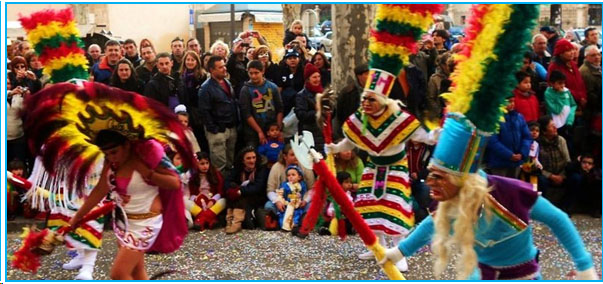If you think that between Christmas and Easter there is not anything important to mark in the Spanish celebration calendar that is why you don’t not know the Carnival Party; A party, which is associated to the countries of Catholic tradition that gives way to Lent (religious period of purification, intended for the preparation of Easter, which included between amongst other tasks, the abstinence of the intake of meat) and permitted any kind of excesses related to food, alcohol, passion, the spree, the performance… In short, a period: permissiveness and certain lawlessness.
Although the fulfilment of the mandatory required by the Lent has been relegate as the years passed, Carnival has endured from year to year, Spaniards can change of identity during these days to transform themselves to pirates, witchs, superheroes, or princesses and be transformed to the character that they always have dreamt for a few days.
Spanish streets and squares are dyed by a color, magic, masks, wigs, dances, music and imagination, a lot of imagination. The rituals and formulas to celebrate Carnival are the most varied ones and they usually vary from one region to another:
The Carnival of Santa Cruz de Tenerife (Canary Islands)
 It is considered the second most famous Carnival in the world level, after the Carnival in Rio de Janeiro in Brazil. This is declared party of International Tourist Interest by the Secretary of the State for Tourism, currently the Carnival of Santa Cruz de Tenerife hopes to be transformed in Heritage by UNESCO.
It is considered the second most famous Carnival in the world level, after the Carnival in Rio de Janeiro in Brazil. This is declared party of International Tourist Interest by the Secretary of the State for Tourism, currently the Carnival of Santa Cruz de Tenerife hopes to be transformed in Heritage by UNESCO.
The Carnival of Santa Cruz de Tenerife counts with two well differentiated parts:
- The Official Carnival: murgas, comparsas, groups of costums, musical groups…
- The Carnival Street, featured by the participation of the population.
The coronation of the Queen of Carnival is one of the best emotional moments of the celebration.
 The Carnival of Cadiz (Andalusia)
The Carnival of Cadiz (Andalusia)
It is declared, like the Carnival of Santa Cruz de Tenerife, an International Tourist Interest one. The Carnival of Cádiz is known for its originality, its joy, its party in the street and mainly for the local participation. “The chirigotas” are specially known, satirical groups between ten and twelve people, who portray the current political and social affairs through known songs as “cuplés.” A visual show full of grace, music and colour.
Palma de Mallorca (Balearic Islands)
In Palma the Carnival party starts with the dijous llarder (Fat Thursday) and is last during the entire weekend with concerts, dances, music in the street, coachs and parades dressed up. It is very typical during these days eat coca de tallades o ensaimada de tallades. Although Sa Rua de Palma is considered the most important parade, Carnival is celebrated with great enthusiasm and cheering in the whole island. This is a unique opportunity to discover Mallorca and the mallorcan magic.
LA CELEBRACIÓN DE CARNAVAL EN ESPAÑA
Si crees que entre Navidad y Semana Santa no hay nada importante que marcar en el calendario de festividades españolas es porque no conoces la fiesta de Carnaval; Una fiesta asociada a los países de tradición católica que daba paso a la Cuaresma (período religioso de purificación, destinado a la preparación espiritual de la fiesta de Pascua, que incluía entre otros cometidos el de la abstinencia de ingesta de carne) y que permitía todo tipo de excesos relacionados con la comida, el alcohol, la pasión, la juerga, el espectáculo… En definitiva, un período de permisividad y cierto descontrol.
Si bien el cumplimiento de los mandatos que exigía la Cuaresma han ido quedando relegados con el paso de los años, el Carnaval ha perdurado permitiendo que año tras año, los españoles y españolas puedan cambiar de identidad durante estos días para convertirse en piratas, brujas, superhéroes, princesas o transformarse durante unos días en el personaje que siempre han soñado.
Las calles y plazas españolas se tiñen de colores, magia, antifaces, pelucas, bailes, música e imaginación, mucha imaginación. Los rituales y fórmulas a la hora de celebrar el Carnaval son de lo más variopintas y suelen variar de una región a otra:
EL CARNAVAL DE SANTA CRUZ DE TENERIFE (ISLAS CANARIAS)
Es considerado el segundo carnaval más conocido a nivel mundial, después del Carnaval de Río de Janeiro en Brasil. Declarada fiesta de Interés Turístico Internacional por la Secretaría del Estado para el Turismo, en la actualidad el Carnaval de Santa Cruz de Tenerife aspira a convertirse en Patrimonio de la UNESCO.
El Carnaval de Santa Cruz de Tenerife cuenta con dos partes bien diferenciadas:
- El Carnaval oficial: murgas, comparsas, grupos de disfraces, agrupaciones musicales…
- El Carnaval de la calle, destacado por la participación ciudadana en la fiesta.
La coronación de la reina del Carnaval es uno de los momentos más emotivos de la celebración.
EL CARNAVAL DE CÁDIZ (ANDALUCÍA)
Declarado, al igual que el Carnaval de Santa Cruz de Tenerife, de Interés Turístico Internacional. El Carnaval de Cádiz es conocido por su originalidad, su alegría, su fiesta en la calle y sobre todo por la participación popular. Son especialmente conocidas “las chirigotas”, agrupaciones satíricas que oscilan entre diez y doce personas y que retratan la actualidad política y social a través de canciones conocidas como “cuplés”. Un espectáculo visual repleto de gracia, música y color.
PALMA DE MALLORCA (ISLAS BALEARES)
En Palma las fiestas de Carnaval comienzan con el dijous llarder (jueves lardero) y se prolongan durante todo el fin de semana con conciertos, bailes, música en la calle, carrozas y desfiles de comparsas disfrazadas. Es muy típico durante estos días comer coca de tallades o ensaimada de tallades Aunque Sa Rua de Palma es considerado el desfile más destacado, el Carnaval se celebra con gran entusiasmo y ovación en toda la isla. Una oportunidad única para descubrir Mallorca y la magia mallorquina.

